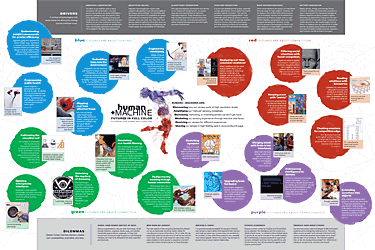Future Now
The IFTF Blog
The Purple Transformation: A Human+Machine Futures Scenario
The year is 2025. Those weird headsets you saw your favorite pro basketball team wear—those new expensive hats that, according to the ads, interfere with your brainwaves to help you focus—it seems like brain-machine wearables are everywhere.  And leading the charge of this new wave of technology is one company: Amethyst Corp. Holding an exclusive contract with many pro sports leagues, Amethyst manufacturers wearables that allow teammates to communicate with each-other simply through thought. In pro basketball, Amethyst’s TeamPlus headsets lead to a 65% reduction in turnovers in the first year used; Amethyst stock jumped 140% in Q1 or 2025 alone.
And leading the charge of this new wave of technology is one company: Amethyst Corp. Holding an exclusive contract with many pro sports leagues, Amethyst manufacturers wearables that allow teammates to communicate with each-other simply through thought. In pro basketball, Amethyst’s TeamPlus headsets lead to a 65% reduction in turnovers in the first year used; Amethyst stock jumped 140% in Q1 or 2025 alone.
The Human Brain is Perfect Already, Amethyst’s motto states. Don’t Let Old Technology Hold You Back. As neuroscience converges with engineering, startups tackle the challenge of building devices to help our brains communicate with others, accomplish new tasks, and boost productivity.
It seems like no matter what you do, brain-machine devices can help you do it better. For the elderly, implants help the brain make new long-term memories as Alzheimer’s slowly sets in. Executive Boards mandate CEOs where Amethyst Aligns, which assist with focus, concentration, and ethical decision-making. Even in relationships, Amethyst Hearts help couples temporarily at long-distance express emotions back and forth in real-time, creating a constant connection.
The future of the interface has nothing to do with your hands—it’s all in your head.
The future is here, and it's … weird
Since the dawn of technology, our interactions with machines have halted before the brain barrier. Sure, touchscreens might make computers easier to use than text entry fields, but your hands are still doing the work.
This new generation of technology, however, seems to have crossed an invisible line, obscuring the sacred boundary between humans and their machines. When you can control a computer just by thinking about it, to some extent, the computer becomes part of you. When Amethyst Travel listens to any language and then translates into English in real time, wearers become fluent in every language all at once; we have finally put the power of the processor and cloud supercomputing to the task, now that these powers are uncoupled from the restrictions of limited interfaces.
A long time coming
Although this might sound like a stretch, our brains are already in intricate symbiotic relationships with machines. A simple example, one of millions, is that using GPS devices to offload the cognitive task of making sense of maps might increase long-term risks of dementia. A well-developed hippocampus, the part of the brain that grows when we use spatial thinking and withers when we rely too heavily on maps, corresponds to a resistance to dementia. As Father John Culkin once said: “We create our tools and thereafter our tools shape us.” The intimacy of our reliance on machines changes how we think, connect, compete, and improve ourselves.
A scenario about transformation in human+machine futures
 This scenario is one of the four possibilities we imagined in our new map, Human+Machine Futures in Full Color: Extending Our Senses and Ourselves, the first in our 2015 Technology Horizons program’s series of projects about Human+Machine Futures—the blurring lines between human and machine, natural and artificial. The map forecasts how emerging technology is creating what are today vast and unknown territories of human sensory experience. Rooted in the color-based systems mythology tool IFTF developed in 2014, we intended for the map’s forecasts, scenarios, and artifacts from the future to help us imagine how the future of human-machine symbiosis will be colored by our priorities, concerns, and values.
This scenario is one of the four possibilities we imagined in our new map, Human+Machine Futures in Full Color: Extending Our Senses and Ourselves, the first in our 2015 Technology Horizons program’s series of projects about Human+Machine Futures—the blurring lines between human and machine, natural and artificial. The map forecasts how emerging technology is creating what are today vast and unknown territories of human sensory experience. Rooted in the color-based systems mythology tool IFTF developed in 2014, we intended for the map’s forecasts, scenarios, and artifacts from the future to help us imagine how the future of human-machine symbiosis will be colored by our priorities, concerns, and values.
The Purple scenario and artifact from the future are about transcendence and transformation—how seemingly linear and progressive advances in technology can yield devices and experiences that radically change what it feels like to be human. We can see this come to life in Amethyst’s brain-machine wearables, and how these new technologies ‘sit on top of’ existing experiences, but by interfacing directly with the brain reshape the fundamental experience at hand, essentially erasing the distance between humans and computers.
Signals of this Future today
We are building a tomorrow of computers and human brains working side-by-side in new and more intimate ways. While much of this work is not yet commercialized, a surprising amount of it is, or will be within 5 years.
The human brain is the world’s most complicated piece of hardware. Emerging work in the fields of neuroscience and cognitive science are helping improve our education approaches to optimize for learning. Books like the Social Neuroscience of Education state that social contexts at different points in life can be used to help learn; brain games like Lumosity claim to advance this field as well. In reality, playing the commercially successful puzzle solving game Portal 2 was proven to be a more effective learning tool than Lumosity. Compare this to how people learned 200 years ago, when rote memorization was the dominant approach. Measuring the cognitive impact of different activities will likely lead to pedagogical approaches that look as different from where education stands today as it did 200 years ago. The incredible game Throw Trucks With Your Mind is perhaps the best example of this- using a head-mounted-device that measures brain waves to train players how to achieve calm and focus as a treatment for ADHD, PTSD, and other conditions.
You carry a big chunk of your brain in your pocket. You remember people’s phone numbers, you calculate sums, you learn about facts and trivia that you previously would have needed to memorize. If you’ve ever caught yourself saying “what did we do before Google?”, you know firsthand how much cognitive load you’ve outsourced to your phone. As we enter a world of more immediate interfaces, like AR glasses, we’ll be able to even more fluidly incorporate machine intelligence into our own. For instance, the Google glass translate app, which translates in real-time within the glass’s lens, means you might never need to learn to read another language. Expect to see this further impact how we educate, how we work, and the market for information services. Microsoft’s Hololens takes much of the information you want and literally puts it in the physically sensed world.
The human brain is a machine, and sometimes that machine breaks. It degrades, it degenerates. And it also runs on electrical signals. Manmade machines can interface directly with the brain to help improve functioning. However ‘SciFi’ this sounds, we’re already deep into the lab research; Hippocampal Prostheses, designed to allow people with brain damage to be able to make long-term memories again, has been tested heavily in mice and rats. Cochlear implants, though more basic, also use electrical stimulation to help the brain process sound. We might soon see more devices capable of fundamentally augmenting our cognitive capacities.
This post is from one of Technology Horizons 2015 forecast maps, Humans+Machine Futures in Full Color: Extending Our Senses and Ourselves, which explores how advances in technology will create new forms of human-machine symbiosis, expanding and even redefining what we can do with our five senses.
Also see:
Curious about Technology Horizons?
- Follow @iftf
- Find out more about the Technology Horizons program
- Check out previous years' Technology Horizons research
- Contact Sean Ness at sness@iftf.org




